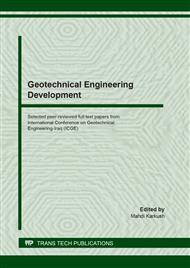p.212
p.221
p.228
p.234
p.243
p.253
p.259
p.266
p.273
Measurement and Calibration of the Parameters of Hypoplasticity Model for an Iraqi Soil
Abstract:
There are many constitutive models that have been used to model the mechanical behavior of soils. Some of these models are either unable to represent important features such as the strain softening of dense sand or required many parameters that can be hard to obtain by standard laboratory tests. Because of that, a more reliable constitutive model, which is capable to capture the main features of the soil behavior with easily obtained parameters, is required. The Hypoplasticity model is considered as a promising constitutive model in this respect. It is considered as a particular class of rate non-linear constitutive model at which the stress increment is expressed in a tensorial equation as a function of strain increment, actual stress, and void ratio. The hypoplastic model required only eight material parameters (critical friction angle critical, maximum and minimum void ratio respectively), granular stiffness hs and the model constants n, α, β). The appealing feature of the hypoplastic model is that the material parameters are separated from the state variables (void ratio and the initial stresses). This feature enables the model to simulate the soil behavior under a wide range of stresses and densities with the same set of material parameters. In this research, a brief description of the Hypoplasticity model is presented. Detailed discussions regarding the measurement and calibration of the model parameters of an Iraqi soil are then exposed. It is concluded that only Consolidated Drained (CD) triaxial test, oedometer test, and the well-known limit density tests are needed to get all the parameters of the hypoplasticity model.
Info:
Periodical:
Pages:
243-252
Citation:
Online since:
August 2020
Authors:
Price:
Сopyright:
© 2020 Trans Tech Publications Ltd. All Rights Reserved
Share:
Citation:


